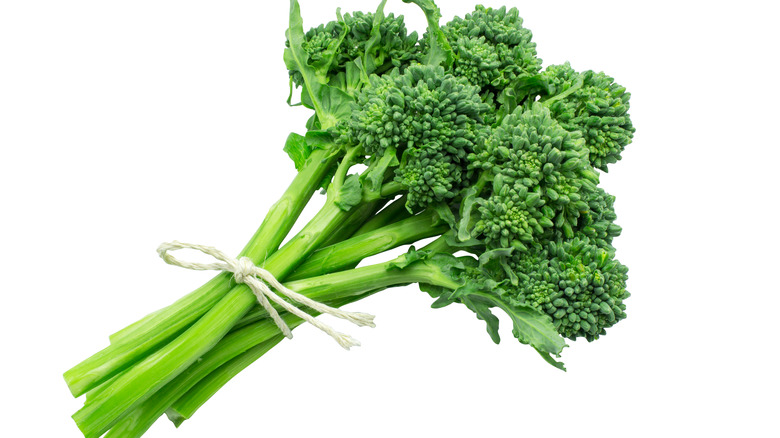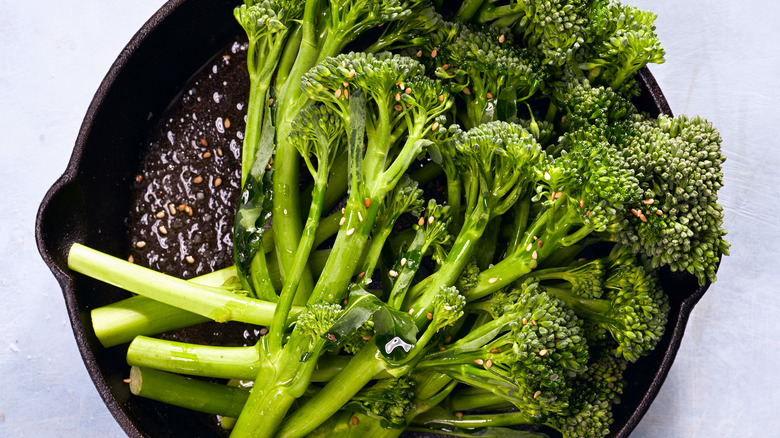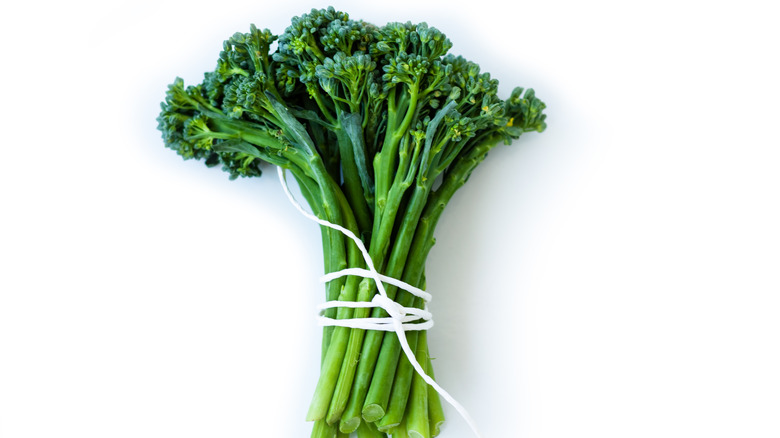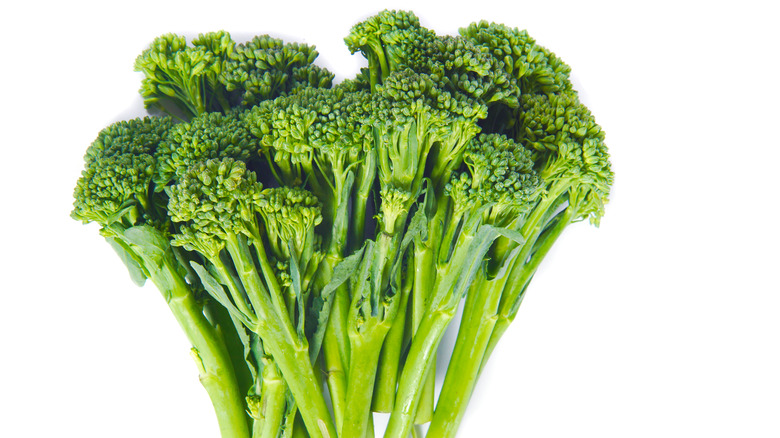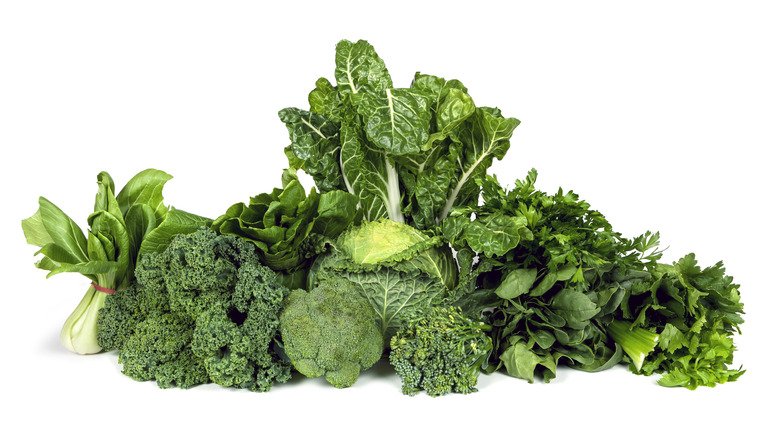What Is Broccolini And What Does It Taste Like
Broccolini, like its big cousin broccoli, is green, has sprouts and stems, and probably isn't the first choice side dish amongst little kids. But what exactly is broccolini, and what makes it different from the more common baby tree known as broccoli? As recounted by Bon Appétit, broccolini is actually the result of crossbreeding between Chinese broccoli and the commonplace broccoli that we're all familiar with. And guess what, broccolini combines the best of both worlds.
One of the major reasons for the recent insurgence of broccolini in the food world is that it's so easy to maneuver and cook with. It's easier to prepare than broccoli, which makes it ideal for throwing together for a last-minute side, and all it takes is a pinch of salt and olive oil to roast or sauté this little green to perfection. But another big part of the appeal is the difference in taste.
What does broccolini taste like?
While broccoli and broccolini share that same fresh, snappy crunch, broccolini is a bit different when it comes to taste. While broccolini is known for its more sweet and mild taste, it also has a splash of spice — though it only remains on your tastebuds momentarily. And similar to most bitter or spicy veggies, when cooked, broccolini tends to sweeten and lose the already mild bitterness it had.
Broccoli and broccolini have fairly similar tastes, but the main difference is broccolini gives off a more delicate feeling in its sweetness that is more akin to asparagus than the rather plain flavor of your typical broccoli. And given that broccolini already has the best of both worlds between broccoli and Chinese broccoli, combines the taste of broccoli and asparagus, and is chock full of health benefits, it seems to be a superfood in every sense of the term.
The amazing health benefits of broccolini
On top of its flavor and ease of usage, there's another big reason why broccolini is trending so much in the foodie world. According to the folks at WebMD, broccolini has an immense amount of health benefits. Like all cruciferous veggies, broccolini is loaded with fiber, not only making it easier for your body to digest but even helping to keep your blood sugar levels down. On top of the fiber, broccolini is also full of both vitamin A and D — helping to keep your eyes and skin in tip-top shape — as well as calcium and magnesium to keep your blood pressure in check.
While containing lots of vitamins is always a bragging point, perhaps the ultimate health value of broccolini is its levels of antioxidants. Broccolini boasts both the antioxidant known as sulforaphane and an enzyme called myrosinase. Sulforaphane has a number of abilities, including reducing inflammation and fighting against toxins and cancer. Elsewhere, myrosinase makes antioxidant compounds when you snack on some broccolini that combats different types of cancer. So the next time you're looking for a quick and easy side dish for dinner, remember to invite broccoli's younger cousin.
The strange origin story of broccolini
Yes, broccolini came from broccoli and Chinese broccoli, but oddly enough, it came about by way of Japan. According to Spoon University, the Sakata Seed Company developed what we now know as broccoli back in the 1990s. The idea was to figure out how to extend the broccoli season since it only grows well in cooler environments. With a team of plant and seed experts on hand, they decided the best way to go about it was simply creating a whole new vegetable.
Opting for a method called hand pollination, as opposed to using genetic engineering, it took Sakata Seed Company seven years to create the prototype for the hybrid veggie we now know as broccolini. Only then were the seeds sent to California in order to conduct further research, and even after that, it still took several years of tinkering before they deemed the mission complete. And alas, we have the broccolini.
Broccolini vs. the broccoli world
While it may look and sound like it's a baby version of your standard broccoli or any number of other brocco-centric veggies, there are plenty of traits to broccolini that make it stand apart. We may be familiar with the typical broccoli we were all forced to eat as children, but let's take a look at Chinese broccoli, for starters. Eater relays how broccolini is actually a cross between broccoli and Chinese broccoli, also known as "gai-lan" or Chinese kale. The latter is known for its big leaves and robust flavor, where broccolini tends to have tiny leaves — if there are any at all. Broccolini also has a much more gentle, sweet taste in comparison to both broccoli and Chinese broccoli.
Broccoli rabe, on the other hand, is technically not even related to the broccoli family. In fact, despite it looking a great deal like broccoli or broccolini — with its little florets and green stem — this veggie is actually related to the turnip family. And while all the previously mentioned broccoli buddies cook scrum-diddly-umptiously with garlic, broccoli rabe it is far more bitter, especially compared to broccolini.
The perfect quick broccolini fix
Of course, there is more than one way to fry a fish, and that obviously applies to the broccolini game as well. If you're either new to broccolini or just need a quick brocco-fix, The Kitchn has a fast and easy pan fry recipe that just requires a few additional ingredients. If you're not a fan of pan-fried broccolini, the Food Network has a roasted recipe to help you enjoy this vegetable in all of its crispy glory.
Whichever way you decide to enjoy your broccolini, don't be afraid to experiment! One recipe from The New York Times adds Parmesan cheese to the mix to great effect. You can also toss in some lemon wedges at the end to brighten up the dish. If you're not a fan of lemon, try combining it with some of your favorite spices or cheeses until you find the perfect combination. And voila, a perfect side!
